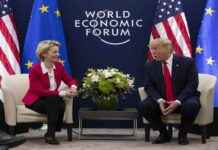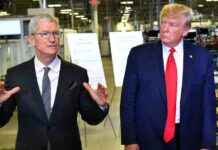President Donald Trump made a bold statement on Monday, confirming that the extensive U.S. tariffs imposed on imports from Canada and Mexico would move forward as planned when the month-long delay on their implementation runs out next week. Speaking at a White House press conference, Trump asserted, “The tariffs are going forward on time, on schedule,” in response to queries about the postponed tariffs on these crucial U.S. trading partners.
The decision to proceed with the tariffs stems from Trump’s belief that the United States has been taken advantage of by foreign nations across various sectors. In an effort to rectify this perceived injustice, he emphasized his intention to enforce reciprocal tariffs. “So the tariffs will go forward, yes, and we’re going to make up a lot of territory,” Trump declared confidently.
The Evolution of Tariffs: From Executive Orders to Diplomatic Agreements
This move follows Trump’s executive orders issued on February 1, which levied 25% tariffs on products from Mexico and Canada, along with 10% duties on Canadian energy exports. The president’s decision was motivated by his concerns over the alleged failure of Mexico and Canada to address issues like crime and drug trafficking along their U.S. borders.
However, just two days after the initial executive orders were signed, Trump opted to delay the implementation of the new tariffs. This decision came in response to assurances from Mexican President Claudia Sheinbaum and Canadian Prime Minister Justin Trudeau, who both pledged to enhance their border security efforts. Trump took to Truth Social on February 3 to announce that the tariffs on Canadian goods would be postponed for 30 days, while the duties on Mexican imports would be held off for a month. During this period, the administration aimed to engage in negotiations with Mexico and work towards a final economic agreement with Canada.
Escalating Tensions and Global Concerns
Trump’s reliance on tariffs as a strategic negotiating tool and revenue stream has sparked concerns both domestically and internationally. The president had previously imposed 10% tariffs on Chinese imports and hinted at reciprocal tariffs on other American trading partners. In response, China retaliated by introducing targeted tariffs on U.S. goods, fueling fears of a potential trade war between the two economic giants.
Similar apprehensions have arisen in the case of Mexico and Canada, longstanding allies and vital trade partners of the United States. Prior to the temporary pause in tariffs, both Trudeau and Sheinbaum had announced plans to impose retaliatory tariffs on American imports, signaling a potential escalation in trade tensions.
As the deadline for the implementation of tariffs on Canada and Mexico approaches, the global economic landscape remains uncertain. The outcomes of these tariff decisions will have far-reaching implications for international trade relations and the geopolitical climate at large. The evolving dynamics between the United States and its key trading partners underscore the complexities of modern economic diplomacy and the delicate balance of power in the global arena.
President Trump’s unwavering stance on tariffs reflects his commitment to reshaping trade policies and addressing what he perceives as imbalances in international commerce. The repercussions of these decisions extend beyond mere economic transactions, shaping the geopolitical landscape and influencing diplomatic relations on a global scale. As the world watches the unfolding developments in U.S. trade policy, the implications of these actions will reverberate far beyond the realm of economics, underscoring the intricate interplay between politics, economics, and global power dynamics.
















